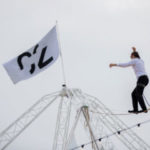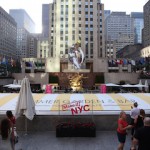Day One: Big City, Big Steaks
It was a bright, sunny August afternoon when I touched down in Chicago, and the first face to greet me was Officer Tony Molyneaux’s. Instead of a typical driver, Choose Chicago had sent the retired sergeant to pick me up from Chicago O’Hare International Airport, a neat perk that the destination marketing organization affords to clients coming to the city for site visits. As we slogged through stop-and-go traffic, I could see why — when you’re listening to stories dug up from decades of service in the Chicago Police Department, the commute goes by in a flash.
It was the perfect time to visit Chicago. It was sunny and temperate, there was alfresco dining on the riverfront calling my name, and McCormick Place was giving me a firsthand look at its long-awaited expansion that will break ground at PCMA’s Convening Leaders 2015 in January.
My first stop — and my host hotel for my three-day stay — was the Hyatt Regency Chicago. The city’s largest hotel and a centerpiece of downtown for 30 years, the AAA Four-Diamond property sits on Wacker Drive near the mouth of the Chicago River, putting guests within a short stroll of Millennium Park, the shiny shops of Michigan Avenue, and the Chicago Riverwalk. In 2013, the Hyatt Regency polished off a $168-million renovation that completely redesigned its lobby, public spaces, dining outlets, and guest rooms.
Previously, the lobby could feel cramped and crowded when a large group checked in all at once, Justin Evans, associate director of sales, said as we walked through the newly bright and airy second-level space. He explained that the expanded lobby, with long, sleek counters that employees walk out from behind to hand over hotel keys a la Nordstrom, and an even bigger Big Bar — the hotel’s sociable lobby bar — have made it feel like a completely different hotel.
“It’s complete in a sense that you now have this communal experience,” Evans said. That experience extends into the hotel’s four dining options, including the new American Craft Kitchen & Bar, a casual, healthier ode to the Midwestern blue-plate special. The restaurant’s loosely defined space on the first level of the hotel’s lobby makes it flexible enough to suit functions of up to 600 guests.
Separated into East and West towers, with 2,019 newly renovated rooms, the Hyatt Regency has divvied up its 228,000 square feet of meeting space throughout the property, allowing for more privacy when multiple groups are meeting at the same time. In addition to the 70,000-square-foot Riverside Exhibit Hall, the hotel offers the 10,000-square-foot Crystal Ballroom, featuring some of the best downtown views in the city, and five separate meeting spaces that have been designed specifically for smaller meetings and conferences. All of the hotel’s meeting space has been recently updated and comes with the highest Internet capacity available in Chicago.
After my tour, I spent a few minutes catching up with Meghan Risch, vice president of corporate communications for Choose Chicago. Besides setting up my itinerary, she had given me a courtesy iPhone, equipped with an Uber account, to use during my stay — another complimentary perk of working with the bureau. Choose Chicago is tasked with selling and marketing Chicago as well as McCormick Place, and earlier this year the organization announced new goals of attracting 2.3 million room nights and 50 new meetings a year — as well as 55 million annual visitors — by 2020. These goals are lofty, but they are also well calculated. Choose Chicago, as well as Chicago itself, has seen a number of positive changes in recent years, from implementing new labor rules at McCormick Place to gaining the supportive leadership of Mayor Rahm Emanuel. And accompanying those changes is new development that will further polish the city’s convention product, including more than 3,500 new hotel rooms opening between now and 2017.
That evening, I made my first foray into one of Chicago’s other tourism staples that has also grown up in recent years — the Chicago culinary scene. It was only fitting that my introduction would begin at a steakhouse — and not just any steakhouse. I went to Gibsons Bar & Steakhouse, an institution so firmly dedicated to steak that the Gibsons Restaurant Group managed to convince the U.S. Department of Agriculture to give it its own level of certification, USDA Gibsons Prime Angus beef. After Managing Partner John Colletti greeted me in the crowded bar area, I was ushered into the even more jam-packed dining room. As it was 6 p.m. on a Monday, I took that as a good sign.
Although for many people Gibsons is the place to come for special occasions, it also has its regulars, which has resulted in a waitstaff that functions impeccably amid seeming chaos. It was impossible not to watch them. They recited details of the menu — a veritable saga of steaks — faster than I could read it, and slipped by one another like cats through a cracked door. Next door is Hugo’s Frog Bar & Fish House, which shares a kitchen with Gibsons as well as a versatile second-floor private-dining space.
I got the feeling that Colletti was the sort to agree with the go-big-or-go-home adage, so I ordered the 32-ounce Gibsons 42 Chop (named for Chicago Bears star Sid Luckman, who wore No. 42) to split, along with a double-stuffed potato, French fries, and sautéed spinach. And then came dessert. Portioned so high they were served with steak knives for slicing, the Chocolate Mousse Pie and the seasonal Strawberry Shortcake dwarfed our leftovers like tiny skyscrapers. I later emailed Colletti that the meal was my culinary Everest.
Day Two: A River Runs Through It
The next day, I told myself that I couldn’t possibly eat again. But when my server at The Gage set a plate of delicately charred Nantucket sea scallops, butter lettuce, and apricots drizzled with sesame vinaigrette in front of me, my appetite was instantly rejuvenated. The Gage sits across from Millennium Park and Michigan Avenue, just a short walk from the Hyatt Regency Chicago, making it a top spot for business lunches and events. The entire 300-seat restaurant, multiple private rooms, and bar areas are available for receptions, sit-down functions, and meetings, and the building, a former millinery, still features remnants of its 19th-century roots, with pea-green subway tiles covering the walls and old-fashioned, trough-like sinks in the bathrooms.
After lunch, I made my way to the Chicago Riverwalk for a cruise aboard Chicago’s Leading Lady. Quick to fill up, the Chicago Architecture Foundation River Cruise is a must for any visitor — even locals told me they like to hop aboard every year. Cruising up and down the Chicago and South Branch rivers, we passed by a wide variety of architectural examples, ranging from the Historical Revival stylings of the Tribune Building to the wave-like exterior of the contemporary Aqua at Lakeshore East. While relaxing on the Leading Lady’s sunny deck, listening to our knowledgeable host expound on the city’s prolific collection of building styles, I thought about what a great activity option the cruise would make for groups. Architecture and history buffs will love the enthusiastic guides, while those more interested in the bar can just sit back and enjoy a cold drink and the views.
Next up on my itinerary was another longtime Chicago institution — the John Hancock Center on Michigan Avenue. At one thousand feet high, the building’s new 360 CHICAGO attraction (formerly the John Hancock Observatory) gives visitors 360-degree panoramic views that on a clear day can stretch to include four states. But there’s a bit of an edge: Visitors can step inside the TILT, a specially made glass-enclosed space that, yes, tilts down toward the city at a 30-degree angle. It’s different enough to feel thrilling, but not so adventurous that someone would really freak out. The attraction opened this past May as part of a newly renovated space that can accommodate special events with up to 600 guests.
After a bit (okay, maybe a lot) of shopping on The Magnificent Mile, Chicago’s 13-block stretch of more than 460 stores that ranks as one of the top 10 hospitality, dining, and retail destinations in the world, I cabbed over to the West Loop for dinner at Embeya. My first impression of the 100-seat restaurant was its warmth, which is carried through from its elegant, Bali-inspired function spaces to its Vietnamese-inspired menu and finally to its co-owner Komal Patel, whose genuine hospitality and tell-me-more life stories about traveling the world kept me entranced. After Patel, her husband and Embeya’s director Attila Gyulai, and Executive Chef Thai Dang opened the restaurant in 2012, Embeya quickly began turning heads — Esquire named it one of the best new restaurants of 2013. The cuisine is simple but expertly executed, with flavorful dishes such as mussels bathed in a creamy broth of coconut, lime leaves, and ginger; green papaya salad topped with addicting crispy beef jerky; and roasted-peanut and milk-chocolate mousse. The beauty of the menu is that although Patel and I made our way through most of it, I left feeling satiated yet not overindulged.
Day Three: The Center of It All
I spent my third and final day in Chicago learning about the centerpiece of the city’s convention reinvention — the planned expansion of McCormick Place. General Manager David Causton took the better part of the morning showing me renderings of the two main components of the project — a 10,000-seat event center and a 1,200-room Marriott Marquis hotel — as well as sharing a general overview of what future development might entail. “While we’re building new infrastructure,” Causton said, “we’re also reinvesting in what we have and planning for the future.”
In addition to the new event center, which will function as both the official basketball arena for DePaul University and a space for conventions, trade shows, concerts, general sessions, and other events, the Marriott Marquis property will break ground at the same time in 2015. Both projects have completion dates estimated for 2017. The hotel’s glass tower and adjacent meeting space, housed mostly in the historic American Book Company building next door, will connect directly to the McCormick West Building via skybridge.
Besides 90,000 square feet of meeting space, the Marriott Marquis will offer 47 suites and plenty of amenities, from an indoor pool to a massive marketplace. There are also plans for a new park, which Causton affectionately called a “pocket park,” to be built across the street from the new property. “We want to see more pedestrian traffic around the facility and on the street,” Causton said. “So if it’s a nice day, visitors will feel more inclined to walk along Cermak Road [versus taking the skybridge].”
McCormick Place has already seen a fair share of recent renovations, including a new, full-service Starbucks and café, and the neighboring AAA Four-Diamond Hyatt Regency McCormick Place added a new, 462-room tower and completed a $110-million renovation in 2013. The Metropolitan Pier and Exposition Authority, which already owns McCormick Place and the Hyatt, will also own the new Marriott Marquis and the event center.
After a tour of the center’s new green roof, I headed back downtown for lunch at River Roast, which had opened on the Chicago Riverwalk just days before. Formerly Fultons on the River, the restaurant has a freshly renovated interior with an open kitchen and adjacent chef’s table, attached patios, as well as six private event spaces. The largest, the Murdoch Room, holds up to 450 guests for receptions. James Beard Award–winning Chef Tony Mantuano and Executive Chef John Hogan’s menu, not surprisingly, centers on three kinds of roast — chicken, fish, and beef — which are hand-carved tableside. The roast meats are so popular the restaurant has set up a grab-and-go station in its entryway for customers interested in takeout sandwiches at lunchtime.
Next, I took a walk to Millennium Park, which is currently celebrating its 10-year anniversary. Green spaces are a staple of the Chicago landscape — the city’s official motto is Urbs in horto, Latin for “city in a garden” — and there’s no better example of its commitment to urban greenery than Millennium Park. Garnished with artistic masterpieces such as the futuristically beautiful, Frank Gehry–designed Jay Pritzker Pavilion and sculptor Anish Kapoor’s ever-crowded Cloud Gate (also known as The Bean), the 24.5-acre green space is popular for its uniquely landscaped gardens, including the storybook-meadow-like Lurie Garden. The park also has numerous event spaces, from seasonal tented areas to the 4,000-seat pavilion, whose stage can also serve as a platform for sit-down dinners.
For my last meal in Chicago, Sepia — named after the building’s origins as a turn-of-the-century print shop — offered high-brow Chicago dining at its finest. Besides the main dining room, a symmetrical study in neutral tones with dramatic shaded chandeliers and shimmering mosaic tiled columns, another smaller private space holds groups of up to 100. The Michelin-starred restaurant has Iron Chef winner and James Beard Award finalist Andrew Zimmerman running its kitchen, churning out elevated versions of hearty Midwestern classics, such as the succulent rack of lamb accompanied by baby artichokes and white beans that I chose for dinner. But my personal favorite work of edible art came after — a peach cherry cobbler topped by a cornmeal biscuit and lemon crème-fraîche ice cream. I couldn’t imagine a sweeter ending to my trip.




